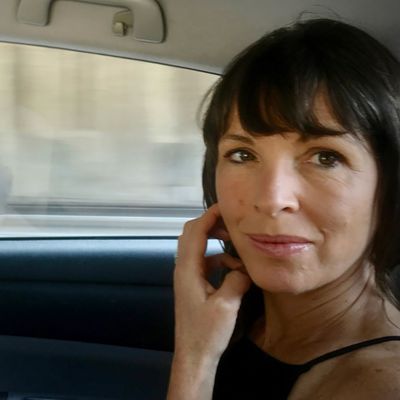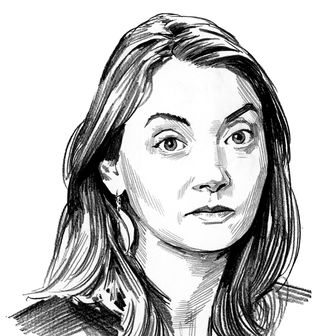
The narrator of Rachel Cusk’s new novel, Second Place, lives at the edge of a marsh, a place of apparent peace. She loves to watch the water moving in over the flat land, advancing stealthily in a silver sheet. People have been lost to the tide; those who live on this coast are lulled by its subtle rhythms. Boundaries melt and reform and melt again, each time with danger slightly closer — and we come to realize the narrator’s mental place of safety is dissolving too. Though there is an identifiable plot in Second Place (something not always true of Cusk’s work), the book is an atmospheric, a mood piece, a drug. Fight it, and it drags you down like undertow.
Cusk has written tidally before. Her Outline novels, a trilogy published between 2014 and 2018, are beautiful but relentless. Although the books all share the same narrator, a woman named Faye, they are mostly constructed from minor characters’ stories. On and on, people monologue at Faye — on planes, in workshops, at restaurants. This flood of detail and observation never reveals Faye’s personality. Instead, it nearly washes her away, saturating the reader’s brain beyond the possibility of absorbing more.
Cusk has often seemed ambivalent about creating identities for her characters. (“I don’t think character exists anymore,” she told The New Yorker in 2018.) Faye rarely looks inward; those books exude a kind of chilly spiritual equipoise. The protagonist of Second Place, however, whom Cusk calls only M, isn’t a sponge. Instead of passivity, we get velocity; M flings herself desperately into her own drama. The novel is the “Outline” trilogy’s narrative opposite: M binges on moral judgment, wallowing in self-examination, measuring and remeasuring every encounter for authenticity and relevance and value.
Set in the modern day, Second Place chronicles M’s relationship with an artist called L — first her encounter with his paintings, then eventually her encounter with the person himself. Cusk draws lightly on the 1932 book Lorenzo in Taos, arts patron Mabel Dodge Luhan’s account of her relationship with D. H. Lawrence. There are elements of autobiography stirred in too; M is a writer, and Cusk herself lived in Norfolk, England, where there’s an estuary very much like M’s marsh. Throughout Second Place, M addresses her account to someone named Jeffers, who she trusts will want to know the full story. (This echoes Dodge’s book, which includes her letters to the poet Robinson Jeffers.)
The first 16 pages are feverish: M, a young mother, is traveling alone in France. There are mentions of a wretched marriage and her own self-loathing. She sees someone on a train whom she calls “the devil,” a frightening, sweating man with a black tooth and a little girl, whom he fondles. It isn’t clear if he’s real, but for M, his presence, and her decision not to confront him, poses some sort of moral question. “If I’d stood up to him, perhaps all the things that happened afterwards wouldn’t have occurred,” M says. “But for once I thought, let someone else do it! And that is how we lose control over our own destinies.”
On the same trip, wandering disoriented through the streets of Paris, she happens across a gallery showing L’s paintings. Somehow, these portraits restore her to herself: Her “impossible yearnings’’ are “crystallised in reverse by the aura of absolute freedom his paintings emanate, a freedom elementally and unrepentingly male down to the last brushstroke.” The more M describes her inner landscape, the blurrier it becomes. Both L’s paintings and the devil seem to be agents of change, their assertive, masculine qualities (in M’s mind) essential for demolition and revival alike.
The story picks up a decade and a half later, after M has left her first husband, battled through a period of suicidality, remarried a kind man named Tony, and retired to the coast on modest authorial laurels. Her daughter, Justine, has grown up, and M no longer worries about work or writing or money. But she seems itchy — and she is still yearning to meet L in person. So she contacts him through a mutual acquaintance and invites him to stay in her guesthouse. When L finally shows up, younger girlfriend in tow, the headlong action stops and events begin to creep forward, like water leaching through the fens. Soon, claustrophobia sets in.
Cusk keeps us oppressively close to M’s thinking, and her sentences grow hypnotic. M is preoccupied by L, thinking incessantly about the painter who shies away from her admiration. She is desperate to be part of his vision, overinterpreting everything. Can he see her? Will he paint her? In one scene, M stares at him while the group listens to her daughter sing:
L merely sat there with a weary look on his face, as though he were using this as an opportunity to think about all the other tiresome things he had been made to sit through. Sometimes he would look up and meet my eye, and something of his separation would become my own. The strangest feeling of detachment, almost of disloyalty, would come over me: even there, in the midst of the things I loved best, he had the ability to cast me into doubt and to expose in myself what was otherwise shrouded over. It was as though, in those moments, his terrible objectivity became my own and I saw things the way they really are.
Second Place is an exploration of how dangerous it is to want to see yourself reflected in the artist’s eye. (Cusk, who is as scrupulous an autobiographer as she is a novelist, may have sharp opinions about this.) Spending nearly 200 pages in the company of M’s clammy intelligence can feel quietly horrifying. There’s very little humor in here. Only Justine’s boyfriend, Kurt, a wannabe writer who dares to wear immaculate, non-workman’s pants to a marsh, is a figure of conscious fun. (I reacted unhappily to the way that Cusk, or at least M, ties together worth and “masculinity”; she is merciless toward Kurt, painting him as an effete dandy, while Tony and L are depicted as virile and strong.)
Cusk knows that her portrait of M and L’s stubbornness and stress-without-breaking can be a heavy read. She gives us little pauses, widescreen shots of natural beauty: a blissful scene of night swimming, descriptions of green valleys that open like books out to sea. But for the most part, the novel is deliberately exhausting. Cusk has turned back to character, but she’s clearly still critical of it; Second Place indulges in stifling excess. You wanted personality? it seems to say. Drown in this.





